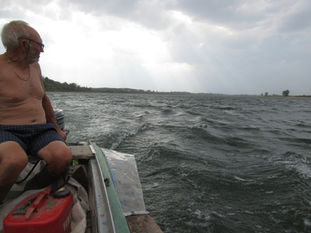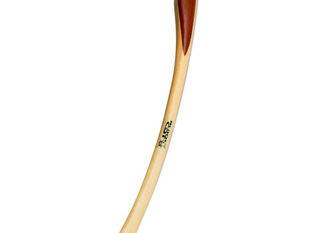
What the cameras had recorded during the night of arrival was the main intrigue in the morning of Day 2. But even before the material was downloaded and processed it was seen that all food left had disappeared. Who were the eaters?
The very first jackal visitor of Season ’24 turned out to be Round Ears. The time of his coming was uncertain as some error with timing had occurred. The clips showed his visit to have been after four a.m., but that looked unlikely. Judging by the bird-songs and the intensity of darkness, it looked more like before midnight – maybe around 23:00 hrs. In any case, the usually very wary Round Ears was more so this time. Perhaps still under the influence of the horrors of the hunting season, he was very hesitant in approaching the bait-site - not to say plainly afraid. As a precaution against evil, he did some twigging:
The next to appear was the Uncle whose wailing had been heard during the night. He was more confident, passed right under the camera and went to look at the people sleeping in their small tents. Then he returned and closed the first round of visits by marking the still overgrown rim of the bait-site:
The Tent.
The recordings of the night downloaded and archived, the main task of Day 2 was to put up the big tent.
This was an army field-hospital, a relic of WW1 (model 1918). As the caption of the ad of the Army Shop said, it was fairly spacious: 5 x 5 metres in size with a central pole 3.5 m high, and a second covering inside, like a ceiling. The sides were supported by 16 two-metre-high poles. With guy-ropes and pegs, the whole thing weighed 275 kg. That was so because the material was pure cotton (when those tents were made plastic did not yet exist).

The canvas was very thick and what with the second canvas ceiling underneath, the tent provided excellent shade during the summer. When all sides were reefed up, only the roof remained and the shade underneath made life bearable. For in late-July-August, temperatures were in the forties.

During the summer, night temperatures are usually in the twenties, but in August even as late as 02:00 a.m., it can be above thirty. In the photo below, on 15 Aug., 2024, the temperature was 31C at two o’clock at night.

The only chance for getting some sleep in such nights is to have only a mosquito net over you and hope that by four in the morning there could be some semblance of coolness. At the same time, the jackals do not show any signs of getting overheated. Nothing like panting or lolling tongues can be seen. Which is the point to say that it is rare that one can see a jackal’s tongue at all. It looks like jackal metabolism in respect of heat is different from that of dogs.
But to go on with the big tent. Once the tent is fully up, and the guy ropes tightened, a cooking range is installed whose flue goes through the roof. Then the floor-panels are set to gain an even surface for the table which also serves as an office desk. The bed with a mosquito net over it is installed, as well as three racks with shelves. The tent is nearly complete.
Energy.
The next big question is energy. This comes from two 280 W solar panels. The whole installation includes a controller, invertor, and two traction batteries. The energy produced supplies my father’s notebook with electricity and reloads the camera-traps’ batteries, that of a cell-phone, and of a still camera. During the day, the panels also keep a small fridge going (in a fashion). During the night the fridge works on propane-butane from a twenty-litre container of liquified gas. A second container supplies a gas-ring for quicker tasks – like brewing coffee.
For emergencies a two-kilowatt electric generator is used – like when the weather has been cloudy. The generator is also used when my father needs to use electric tools.

Water and washing.
Drinking water comes from 10 l bottles of mineral water. When they are empty and there is available transport to the village, they get refilled from the water-fountain of Stanevo’s old church. This is always a memorable occasion in itself.


Kitchen water.
A sink is installed on a plastic table with another at its side with a drying rack. It also provides a surface for processing fish – a task which always asks for a lot of water. That comes from the river. When the water-level is high, the water is taken with buckets and poured into a 40-litre container with a tap standing over the sink. Water-purifying tablets are put in weekly and the container is scrubbed inside and washed every fortnight. Some basic hygiene is thus maintained, but visitors are not much convinced preferring to brush their teeth with bottled water. That cooking is done with river-water they pretend not to know.
Pretending not to know, as my father calls it, helps a lot with life at the camp. I personally practise it when going for a swim. Some of what lives in the river I have seen live and some in books and articles. Thus I find it rather helpful to pretend I never saw any of it and imagine what touches my body is actually pretty-looking tiny fish.
When the water-level gets low, things become more difficult. A major operation is carried out every fortnight to fill up a 300 litre container propped up on an old tree-trunk. The boat goes out into the current to fill up two sixty-litre containers with clean water. The containers are then hauled up on the quad-bike and poured into the big tank. From there the water is carried with buckets to the smaller tank above the sink.

Visitors and Storage.
Apart from the big tent, additional tents are needed for visitors, as well as for storage. These tents have a long and troubled history. The problem here is that when ordinary camping tents are used, they become easy victims of storms.

The trouble is that the roofs of these tents are of paper-thin plastic. Even a small twig falling off a tree during a storm can pierce them. All efforts to repair them proved futile. Under the fierce sun, adhesives dried up, became brittle, and patches would curl up around the edges. Rainstorms would do the rest. Old netting spread over the tents didn’t help either.
The final solution came again from the old army stores. The thing about the old tents is that they are made of thick cotton canvas which is not immune to bullets, but certainly falling twigs are not a problem. An additional advantage is the absence of zips. Once a zip gets damaged on a modern tent, it is as good as gone. Before the invention of the zip, a series of holes and string loops closed and opened tents.

Thus, the solution for the storage tent was found. As for visitors, they were advised to take along their own tents. Since visits did not last for more than a week at a time, and suitable weather would be found for them (with luck), accidents with plastic tents diminished. Or, at least, there were none in Summer ’24.
The sacrificial trunk.
In the autumn of 2022, an evil hand cut down the oldest poplar tree at Km 727. My father had already left in mid-September. In October, his friend Ivo phoned from Stanevo to tell the sad news.
That was a great blow for my father and for myself. My father and mother had taken me to Km 727 when I was two years old. Our tent was pitched under that poplar. Many summers of my childhood were spent under that tree.
The tree was the reason the place was discovered in the first place. Back in 1974, my father and his friend Kolio (Nikolai Kolarov) were canoeing downriver from Vidin. When they had paddled past Lom, and then past the next village of Linevo, they saw a promontory on the horizon which promised breeze and less mosquito-pressure. On paddling closer, they saw a poplar tree rising on the bank. They decided to stop there and pitch their old (canvas) Vango tent in its shade. The tree was already big enough in those days.

By 2022, the tree must have been over half-a-century old. When the evil-doers cut it down, they left the mighty trunk lying on the bank – only the top part was taken.
On its stump, standing waist-high from the ground, my father began leaving bones of big fish. They were for a colony of ants who lived in the roots of the stump. The ants scraped the bones shining clean of the tiniest bit of flesh. This was the sacrifice to the ants. My father said that the ants kept the lightnings away. (I want very much to believe that.)

With the first sacrifice put on the stump, the camp was pronounced complete. Bogdan and Rado left for Sofia in the morning of Day 3. The field-season which was to last for the following three months began.






